Introduction
The process of economic convergence has been the subject of many studies since the mid-1950s. The hypothesis of occurrence of convergence in income was a key conclusion formulated on the basis of neoclassical models of growth, the precursor to which was the Solow-Swan model constructed by Solow (1956). Interest in this phenomenon reached its peak in the 1980s and 1990s, mainly as a result of publication of research by Barro and Sala-i-Martin, recognized as pioneers in this field of science (1991,1992). In order to explain international differences in income per capita, Mankiw, Romer and Weil subsequently expanded upon the Solow growth model, taking physical, human and labor capital into consideration in their works, treating them as components of GDP (1992). Further contributions to research into economic convergence were made by, among others, De la Fuente (1995, 2000), Pritchett (1997), and Temple (1999), as well as Durlauf and Quah (1999, 2009).
One strong trend in economic research is the phenomenon of regionalism, presented in a research study by Florida, Behr et al or Boschma (1995, 2004, 2011). Especially in the second decade of the 21st century, the broadly understood notion of the region found itself at the center of scientific and political discussion. In the region of Western Europe, three countries in particular are notable in this respect: Belgium, the Netherlands and Luxembourg, known as the Benelux countries. Solar et al mentioned, since the Middle Ages, they have been among the continent’s most developed economies, and, at the start of the 20th century, together with the United Kingdom, they occupied the leading positions in Europe’s table of income per capita (1998). The history of cooperation between these countries dates back to the beginning of the last century. Peaslee et al mentioned signing a customs union in 1944 (1974). The Benelux Customs Union was then established on January 1, 1948. Since then, the members of the grouping have been committed to the free movement of goods, capital, services and labor among the three countries, with passport controls lifted on the borders, and the appointment of a Committee of Ministers. Over the years, the form of economic cooperation has evolved. In 1958, the treaty establishing the Benelux Economic Union was signed. The cooperation between Belgium, the Netherlands and Luxembourg has been an example of international economic integration on the European continent since the Second World War. The Benelux countries were a kind of announcement and provided a model for the future model of European integration. The experience of this cooperation was useful in creating the structures of the European Coal and Steel Community, the European Economic Community (EEC), the European Community or the European Union (EU). The new Benelux Treaty was signed on June 17, 2008 in The Hague. The Benelux Union aims to deepen and expand cooperation between the three countries, strengthen and improve cross-border cooperation at all levels. Through better cooperation between the countries, the Benelux tries to promote the prosperity and well-being of the citizens of Belgium, the Netherlands and Luxembourg. Cooperation between the analyzed countries takes place on the basis of an annual plan included in the four-year work program. Agreements between states, for example, result in automatic recognition of all diplomas and degrees in the Benelux countries, political cooperation, including at the summits of the leaders of the Benelux governments, the Benelux treaty on police cooperation, joint roadside checks and Benelux pilotage with digital consignment notes, joint obligations to cooperate on adaptation to climate change, from 2018 tasks performed as part of the functioning of the Benelux Youth Parliament.
The Benelux countries also initiated the Schengen process. An initiative that entered into force in 1985. These three countries have been promoting it since its inception. The cooperation of Belgium, the Netherlands and Luxembourg was constantly adapted to the ongoing socio-economic changes. Currently, it goes beyond mere economic cooperation. Various initiatives are created related to new areas of economic policy, security, sustainable development and broadly understood civilization challenges. Moreover, regional cooperation is also visible in the Pentalateral Energy Forum. It is a regional cooperation group which includes, in addition to the Benelux countries, France, Germany, Austria and Switzerland.
The grouping now plays a role which is, relatively speaking, of less importance, a result, amongst other things, of the development of the European Union. Nevertheless, Benelux is still an economically dynamic and densely populated region. The report published by United Nations Department of Economic and Social Affairs shows that in the analysed area around 5.6% of Europe’s population lives, corresponding to 29.2 mln inhabitants, and where 7.9% of the EU’s total GDP is generated, amounting to € 36,000 per capita, for an area of not more than 1.7% of the total surface area of the EU (2019).
The aim of the article is to verify the stated research hypothesis, which assumes there is economic convergence occurring between the Benelux countries. The countries of Western Europe selected for the analysis are relatively homogenous, follow similar paths in terms of economic policy, as a result not least of their membership of the EU, and are probably seeking to achieve the same state of equilibrium, and therefore ought to show convergent tendencies. Taking into account the long-term cooperation of the regional group, which is Benelux, as well as the growing interest in regional development and cooperation between states in this field, it was decided to select this area for the research. This work fills a gap in research into economic convergence between the Benelux countries.
Materials and Methods
For the purposes of the article, an analysis of processes of economic convergence was conducted using two methods. First, an estimate was made of convergence of type σ, followed by one of convergence of type β. For the analysis, cross-sectional data were used from three Western European countries: Belgium, the Netherlands and Luxembourg, making up the region known as Benelux. The adopted time horizon was 1995 to 2019. Processes of economic convergence were analyzed over two-time intervals, to conduct an analysis of the process of economic convergence prior to the 21st century and in the first two decades of the new century. The first-time interval covered the years from 1995 to 1999, with the aim of examining the process of convergence at the end of the 20th century. The second-time interval has been divided into four-time subgroups which covered the years: 2000 – 2005, 2006 – 2010, 2011 – 2015, 2016 – 2019. The time period, as well as the choice of statistical data, were dictated by an analysis of the subject literature and the availability of data. In this paper, economic convergence was estimated on the basis of Gross National Product per capita according to the purchasing power parity of the euro, which came from the database of the European Statistical Office.
The approach employed in this work was defined with reference to neoclassical models of growth constructed by Solow or Mankiw et al (1956, 1992), which assume the feasibility of convergence at the level of income. The classical Least Squares Method was used in the process of identifying and assessing processes of convergence in income in three countries: Belgium, the Netherlands and Luxembourg. An analysis of cross-sectional data consisted of performing an estimation of β-type convergence using the following formula:

where:
Inyo0– the natural logarithm of GDP per capita at purchasing power parity in the initial period
Inyot – the natural logarithm of GDP per capita at purchasing power parity in the final period
t – the number of periods.
The dependent variable in equation (1) is the average rate of growth in real GDP per capita over the analyzed period. A negative value of the parameter α1 indicates the presence of absolute convergence of type β. This implies the estimation of the β coefficient according to the formula (2).

If this parameter takes a negative value and is statistically significant, then there can be said to be an ongoing process of absolute convergence. In the case where the value of the parameter is positive and statistically significant at the same time in the analyzed area, then there is a phenomenon of regional divergence. According to the convergence hypothesis, less developed countries develop faster than more developed countries, and, as a result, gradually catch up with them from the point of view of development, and especially in terms of the average level of income per capita. The rate of convergence of type β, proposed by Sala i Martin (1996), was assessed on the basis of:

where:
Yi,t,t+T– the rate of growth of GDP per capita in the i-th economy in the years t – t + T
Yi,t– GDP per capita in the i-th economy in the initial year
Yi,t,t+T– GDP per capita in the i-th economy in the final year
t + T – the final year of observation
t – the initial year of observation.
The next step was the estimation of σ convergence. This type of convergence occurs when the dispersion of income between the countries studied decreases over time. Standard deviation, variance or the coefficient of variation are used to measure this phenomenon described by Monfort (2008). In this work, to measure σ-convergence in the period t (t = 1, 2, …, T), the standard deviation of the natural logarithms of the level of GDP to the average values in the period t was used. The calculation was performed on the basis of the formula:

where:
sd (Inyi)t– the standard deviation of the natural logarithm of GDP per capita
at purchasing power parity between regions in the year t
t – the number of periods.
It is possible to talk about the occurrence of processes of σ-convergence when the value of the standard deviation decreases from one period to another. This convergence is synonymous with a decrease in dispersion of income over time.
Results
On the basis of the cross-sectional data collected from the three countries, namely Belgium, the Netherlands and Luxembourg, an analysis of convergence processes of type σ and β over two compared periods. The value of income per capita was used for the estimation. In the last year taken for analysis, the highest level of GDP per capita was achieved by the economy of Luxembourg (Fig. 1), which was significantly above that of the EU-27 average, amounting to € 27,970.
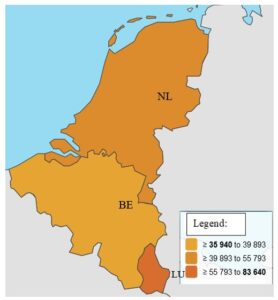
Fig 1: Real GDP per capita (€) in 2019
Source: Author’s own elaborations based on: ec.europa.eu/eurostat/databrowser/, accessed: 12/2020
The first step in the studies conducted was an estimation of σ-type convergence for the five time intervals between Belgium, the Netherlands and Luxembourg (Tab. 1).
Table 1: Regression results for σ-convergence for the Benelux countries

Source: Author’s calculations
Differences in GDP per capita between Belgium, the Netherlands and Luxembourg increased both at the end of the 1990s and in the first two decades of the 21st century.
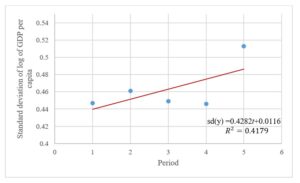
Fig 2. Standard deviation of GDP per capita, time interval: 1995-1999
Source: Author’s calculations
Differences in the levels of GDP per capita between the Benelux countries increased in the years from 1995 to 1999 (Fig. 2), which indicates an absence of σ-convergence. The largest increase in the income gap between the three Western European countries was in the last two years of the 20th century.
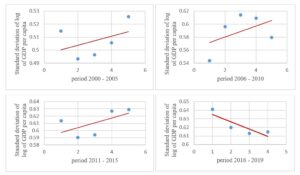
Fig 3. Standard deviation of GDP per capita, time interval divided into four-time subgroups
Source: Author’s calculations
Figure 3 illustrates the standard deviation in levels of the logarithm of GDP per capita in Belgium, the Netherlands and Luxembourg, divided into time subgroups: 2000 – 2005, 2006 – 2010, 2011 – 2015, 2016 – 2019. Based on the results obtained from the estimation of σ-convergence, it should be noted that the differences in incomes between the Benelux countries were characterized by a growing trend, meaning there was no σ-convergence in the three-time subgroups. In the last time interval 2016 – 2019, the differences in incomes between the analyzed countries were characterized by a decreasing tendency, meaning there was σ-convergence in this period. Differences in the levels of income per capita increased for the analyzed area from 0.51 in 2000 to 0.62 in 2019. The largest increase in the gap in economic growth occurred between 2001 and 2008. At the end of the analyzed period, i.e., as of 2016, differences in income decreased.
The second part of the analysis concerns the estimation of β-convergence between the Benelux countries. Based on the results obtained from the studies, no occurrence of this type of convergence was found in the year from 2000 to 2005 and from 2006 to 2010 between the countries selected for analysis (Tab. 2).
Table 2: Regression results for β-convergence for the Benelux countries

Source: Author’s calculations
Based on the value of the parameter there was found to be no convergence of type β. The Benelux countries are thus not becoming more similar to each other, regardless of the initial conditions. The country which is closest to the trend line is Luxembourg (Fig. 4), which achieves the best results in terms of GDP per capita compared to the other Benelux countries. Luxembourg showed the fastest rate of economic growth from 1995 to 1999, while the Netherlands was second in this respect.
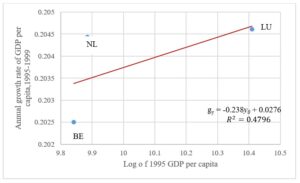
Fig 4. GDP per capita growth rate over the period 1995-1999 and the initial GDP per capita level in Benelux
Source: Author’s calculations
Similar relationships to those in the last decade of the 20th century were observed in the three subgroups’ time interval selected for the research. (Fig. 5). Nevertheless, the R2 value increased significantly with respect to the value obtained for the years from 1995 to 1999, mainly due to the results obtained for Belgium and the Netherlands, which deviated from the trend line to a lesser degree.
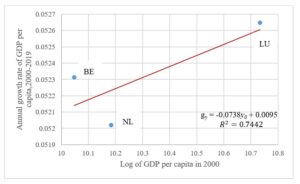
Fig 5. GDP per capita growth rate over the period 2000-2019 and the initial GDP per capita level in Benelux
Source: Author’s calculations
In the years 2011 – 2015 and 2016 – 2019, occurrence of this type of convergence was found between the countries selected for analysis. Luxembourg showed the fastest economic growth in the first two decades of the 21st century. Based on the estimation performed, it should be noted that the economies which in 2000 were characterized by a higher level of income per capita achieved a faster rate of economic growth on average in the years 2000 to 2019 than the countries that had a higher level of income per capita in the initial year of observation.
Discussion and Conclusion
The hypothesis of economic convergence within member states of the European Union has been empirically presented in many research works, prepared by Yin et al, Färe et al, Welsch et al, etc. (2003, 2006, 2008). Research started to be conducted in this area at the end of the 20th century. Ben-David examined the impact of liberalization of trade on convergence in income (1993). Marques and Souikiazus analyzed the sigma and absolute beta convergence process in the EU-12 countries from 1975 to 1995 (1998), and Yin et al have done likewise for the period from 1960 to 1995 (2003). Matkowski and Próchniak studied convergence between eight EU accession countries of Central and Eastern Europe with regard to their levels of income. The rate of growth in GDP from 1993 to 2001 was generally negatively correlated with the initial level of GDP per capita (2007). Rapacki and Próchaniak defined the impact of EU enlargement on economic growth in ten new member states of Central and Eastern Europe (CEE-10) over the period from 1996 to 2007. They then tested hypotheses of sigma convergence and absolute beta convergence in the EU-25, CEE-10 and EU-15 over the period from 1996 to 2007 and over two sub-periods: 1996 to 2001 and 2001 to 2007 (2009). Mathur examined the process of convergence in the European Union from 1961 to 2001 (2005). Cavenaile and Dubois studied the process of convergence in 27 member states of the European Union over the time interval from 1990 to 2007 (2011). Borsi and Metiu investigated real convergence in income per capita in the European Union, demonstrating the absence of any overall convergence in income in the EU (2015). The starting point for analysis of growth regression continues to be the definition of ongoing processes of economic convergence.
On the basis of the studies conducted, the stated research thesis was partly falsified. When analyzing the results of an estimation of convergence of type σ and type β, for which GDP per capita was used, it was shown that at the end of the 20th century a process of economic divergence occurred between Belgium, the Netherlands and Luxembourg. The conducted estimation shows that the σ –convergence occurred between the Benelux countries only in the time period 2016 – 2019. The studies showed that there was no occurrence of β-convergence between the analyzed countries of Western Europe in the time intervals 2000 – 2005 and 2006 – 2010. There was also shown to be β-convergence in the years from 2011 to 2015 and 2016 to 2019, and it should thus be noted that differences in the levels of GDP per capita between the Benelux countries decreased in this period. The dominant country in terms of economic growth compared to the other Benelux countries is Luxembourg. The countries which make up the Benelux grouping are homogenous and follow similar paths in terms of economic policy. Despite many similarities from a historical, geographical, cultural, and even economic point of view, there was no economic convergence between them at the turn of the millennium. The situation improved only in the second decade of the 21st century and the level of prosperity between the Benelux countries began to equalize.
(adsbygoogle = window.adsbygoogle || []).push({});
References
- Barro, R. J. (1991) Economic growth in a cross – section of countries, Quartely Journal of Economics, no 106, 407 – 443.
- Barro, R. J. and Sala-i-Martin, X. (1992) Convergence. Journal of political Economy, 223-251.
- Behr, T. and Jokela, J. (2011) Regionalism & Global Governance: The Emerging Agenda.
- Ben-David, D. (1993) Equalizing Exchange: Trade Liberalization and Income Convergence. The Quarterly Journal of Economics, MIT Press, Volume 108(3), 653-79.
- Borsi, M.T. and Metiu, N. (2015) The evolution of economic convergence in the European Union. Empir Econ 48, 657–681, https://doi.org/10.1007/s00181-014-0801-2.
- Boschma, R.A. (2004) Competitiveness of Regions from an Evolutionary Perspective”, Regional Studies, vol. 38.9.
- Cavenaile, L. and Dubois, D. (2011) An empirical analysis of income convergence in the European Union. Applied Economics Letters, 18(17), 1705-1708.
- De la Fuente, A. (1995) Catch-up, Growth and Convergence in the OECD, No. 314.95, Unitat de Fonaments de l’Anàlisi Econòmica (UAB) and Institut d’Anàlisi Econòmica (CSIC).
- De la Fuente, A. (2000) Convergence across countries and regions: theory and empirics. Available at SSRN 231963.
- Durlauf, S. N. (2009) The rise and fall of cross-country growth regressions. History of Political Economy, 41(Suppl_1), 315-333.
- Durlauf, S. N. and Quah, D. T. (1999) The new empirics of economic growth. Handbook of macroeconomics, 1, 235-308.
- Färe, R., Grosskopf, S. and Margaritis, D. (2006) Productivity Growth and Convergence in the European Union. J Prod Anal 25, 111–141, https://doi.org/10.1007/s11123-006-7134-x.
- Florida, R. (1995) Toward the learning region, Futures, vol. 27, no. 5.
- Mankiw, N.G., Romer, D. and Weil, D.N. (1992) A Contribution to the Empirics of Economic Growth, The Quarterly Journal of Economics, 407-437.
- Marques, A. and Soukiazis, E. (1998) Per Capita Income Convergence across Countries and across Regions in the European Union: Some New Evidence. In International Meeting of European Economy, 389-420.
- Mathur, S. K. (2005) Economic Growth & Conditional Convergence: Its Speed for Selected Regions for 1961-2001. Indian Economic Review, 185-208.
- Matkowski, Z. and Próchniak, M. (2007) Economic Convergence Between the CEE-8 and the European Union, Eastern European Economics, 45:1, 59-76, DOI: 10.2753/EEE0012-8775450103.
- Monfort, P. (2008) Convergence of EU regions: Measures and evolution. Brussels: European Commission, Regional Policy, 3.
- Overall total population” – World Population Prospects: The 2019 Revision” (xslx). population.un.org (custom data acquired via website). United Nations Department of Economic and Social Affairs, Population Division.
- Peaslee, A. J. and Xydis, D. (1974) International governmental organizations. BRILL, 165. ISBN 978-90-247-1601-2.
- Pritchett, L. (1997) Divergence, big time. Journal of Economic perspectives, 11(3), 3-17.
- Rapacki, R. and Próchniak, M. (2009) The EU Enlargement and Economic Growth in the CEE New Member Countries, European Economy. Economic Papers (367), 3-4.
- Sala-i-Martin, X. (1996) The Classical Approach to Convergence Analysis, Economic Journal, no 106, 1019-1036.
- Solar, P. M. and de Jong, H. J. (1998) The Benelux Countries. In: Foley B.J. (eds) European Economies Since the Second World War. Palgrave Macmillan, London, 102, https://doi.org/10.1007/978-1-349-26565-7_5.
- Solow, R. M. (1956) A contribution to the theory of economic growth. The quarterly journal of economics, 70(1), 65-94.
- Temple, J. (1999) The New Growth Evidence. Journal of Economic Literature, 37(1), 112-156.
- Welsch, H. and Bonn, U. (2008) Economic convergence and life satisfaction in the European Union. The Journal of Socio-Economics, 37.3, 1153-1167.
- Yin, L., Zestos, G. and Michelis, L. (2003) Economic Convergence in the European Union. Journal of Economic Integration, 18(1), 188-213. Retrieved February 6, 2021, from http://www.jstor.org/stable/23000737.













